NCERT Solutions Class 10 Maths
Chapter – 11 (Constructions)
The NCERT Solutions in English Language for Class 10 Mathematics Chapter – 11 Constructions Exercise 11.1 has been provided here to help the students in solving the questions from this exercise.
Chapter : 11 Constructions
Exercise – 11.1
In each of the following, give the justification of the construction also:
1. Draw a line segment of length 7.6 cm and divide it in the ratio 5 : 8. Measure the two parts.
Solution – Steps of Construction:
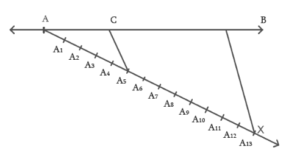
Step I – Draw AB = 7.6 cm
Step II – Draw ray AX, making an acute angle with AB
Step III – Mark 13 (i.e, 5 + 8) points as A₁, A₂ ,…. A₁₃ on AX such that AA₁ = A₁A₂ = A₂A₃ = …… A₁₂A₁₃
Step IV – Join BA₁₃
Step V – Through A₅ (since we need 5 parts to 8 parts) draw CA₅ parallel to BA₁₃ where C lies on AB.
Now AC : CB = 5 : 8
By measurement, we find that AC = 2.9 cm and CB = 4.7 cm
Proof :
CA₅ is parallel to BA₁₃
By Basic Proportionality theorem, in ΔAA₁₃B
AC/BC = AA₅/A₅A₁₃ = 5/8 (By Construction)
Thus, C divides AB in the ratio 5 : 8.
2. Construct a triangle of sides 4 cm, 5 cm and 6 cm and then a triangle similar to it whose sides are 2/3 of the corresponding sides of the first triangle.
Solution – Steps of Construction:
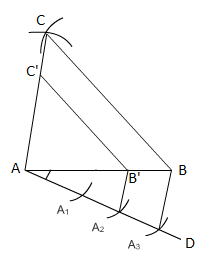
Step I – Draw BC = 6 cm. With B and C as centres and radii, 5 cm and 4 cm respectively draw arcs to intersect at A. ΔABC is obtained.
Step II – Draw ray BX making an acute angle with BC.
Step III – Mark 3 (since, 3 > 2 in the ratio 2/3) points B₁, B₂, B₃ on BX such that BB₁ = B₁B₂ = B₂B₃.
Step IV – Join B₃C and draw a line through B₂ (second point where 2 < 3 in the ratio) parallel to B₃C meeting BC at C’.
Step V – Draw a line thorough C’ parallel to CA to meet BA at A’. Now ΔA’BC’ is the required triangle similar to ΔABC where BC’/BC = BA’/BA = C’A’/CA = 2/3
Proof:
In ΔBB₃C, B₂C’ is parallel to B₃C.
Hence by Basic proportionality theorem,
B₂B₃/BB₂ = C’C/BC’ = 1/2
Adding 1 to both the sides of C’C/BC’ = 1/2,
C’C/BC’ + 1 = 1/2 + 1
(C’C + BC’)/BC’ = 3/2
BC/BC’ = 3/2
or BC’/BC = 2/3 —————- (i)
Consider ΔBA’C’ and ΔBAC
∠A’BC’ = ∠ABC (Common)
∠BA’C’ = ∠BAC (Corresponding angles ∵ C’ A’ ||CA)
Hence by AA similarity, ΔBA’C’ ~ ΔBAC
Corresponding sides are proportional
BA’/BA = C’A’/CA = BC’/BC = 2/3 [From equation (i)]
3. Construct a triangle with sides 5 cm, 6 cm and 7 cm and then another triangle whose sides are 7/5 of the corresponding sides of the first triangle.
Solution – Steps of Construction:
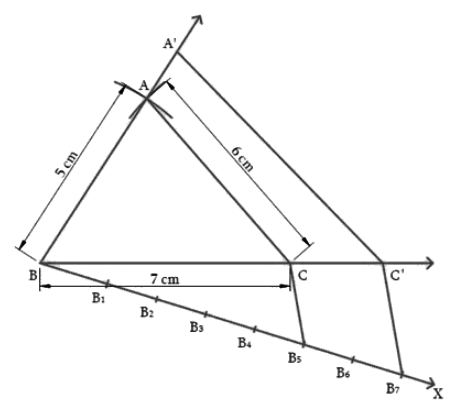
Step I – Draw BC = 7cm with B and C as centres and radii 5 cm and 6 cm respectively. Draw arcs to intersect at A. ΔABC is obtained.
Step II – Draw ray BX making ∠CBX an acute angle.
Step III – Mark 7 points (greater of 7 and 5 in 7/5 ) B₁, B₂,………B₇ on BX such that BB₁ = B₁B₂ =…………… = B₆B₇
Step IV – Join B₅ (smaller of 7 and 5 in 7/5 which is the 5th point) to C and draw B₇C’ parallel to B₅C intersecting the extension of BC at C’.
Step V – Through C’ draw C’A’ parallel to CA to meet the extension of BA at A’. Now, ΔA’ B’C’ is the required triangle similar to ΔABC where BA’/BA = C’A’/CA = BC’/BC = 7/5
Proof :
In ΔBB₇C’, B₃C is parallel to B₇C’
Hence by Basic proportionality theorem,
B₅B₇/BB₅ = CC’/BC = 2/5
Adding 1 to both the sides of CC’/BC = 2/5,
CC’/BC + 1 = 2/5 + 1
(BC + CC’)/BC = 7/5
BC’/BC = 7/5
Consider ΔBAC and ΔBA’C’
∠ABC = ∠A’BC’ (Common)
∠BCA = ∠BC’A’ (Corresponding angles ∵ CA || C’A’)
By AA criteria, ΔBAC ∼ ΔBA’C’
∴ Corresponding sides are proportional
Hence,
BA’/BA = C’A’/A = BC’/BC = 7/5
4. Construct an isosceles triangle whose base is 8 cm and altitude 4 cm and then another triangle whose sides are 1.5 times the corresponding sides of the isosceles triangle.
Solution – Steps of Construction:
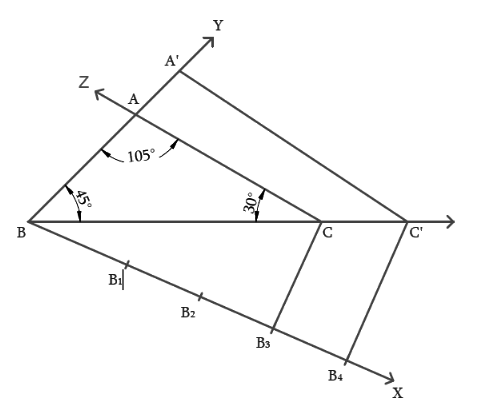
Step I – Draw BC = 8cm.
Step II – Through D, the mid-point of BC, draw the perpendicular to BC and cut an arc from D on it such that DA = 4cm. Join BA and CA. ΔABC is obtained.
Step III – Draw the ray BX so that ∠CBX is acute.
Step IV – Mark 3 (since, 3 > 2 in 112 = 3/2) points B1, B2, B3 on BX such that BB1 = B1B2 = B2B3
Step V – Join B2 (2nd point ∵ 2 < 3) to C and draw B₃C’ parallel to B₂C, intersecting BC extended at C’.
Step VI – Through C’ draw C’A’ parallel to CA to intersect BA extended to A’. Now, ΔA’BC’ is the required triangle similar to ΔABC where BA’/BA = C’A’/CA = BC’/BC = 3/2
Proof:
In ΔBB3C’, B2C || B3C’,
Hence by Basic proportionality theorem,
B2B3/BB2 = CC’/BC = 1/2
Adding 1 to CC’/BC = 1/2
CC’/BC + 1 = 1/2 + 1
(BC+CC’)/BC = 3/2
BC’/BC = 3/2
Consider ΔBAC and ΔBA’C’
∠ABC = ∠A’BC’ (Common)
∠BCA = ∠BC’A’ (Corresponding angles ∵ CA || C’A’)
∠BAC = ∠BA’C’ (Corresponding angles)
By AAA axiom, ΔBAC ~ ΔBA’C’
∴ Corresponding sides are proportional
Hence,
BA’/BA = BC’/BC= C’A’/CA = 3/2
5. Draw a triangle ABC with side BC = 6 cm, AB = 5 cm and ∠ABC = 60°. Then construct a triangle whose sides are 3/4 of the corresponding sides of the triangle ABC.
Solution – Steps of Construction:
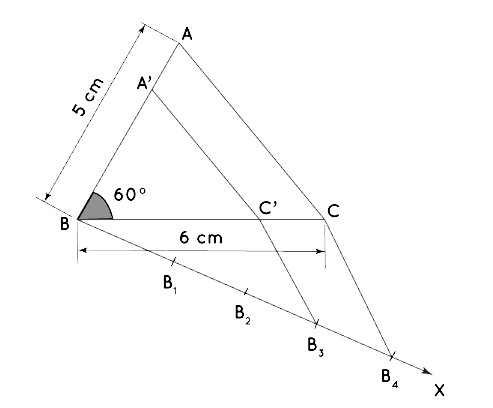
Step I – Draw a line BC = 6 cm.
Step II – At B, make ∠C = 60° and cut an arc at A on the same line so that BA = 5 cm. Join AC, ΔABC is obtained.
Step III – Draw the ray BX such that ∠CBX is acute.
Step IV – Mark 4 (since 4 > in 3/4) points B₁, B₂, B₃, B₄ on BX such that BB₁ = B₁B₂ = B₂B₃ = B₃B₄
Step V – Join B₄ to C and draw B₃C’ parallel to B₄C to intersect BC at C’.
Step VI – Draw C’A’ parallel to CA to intersect BA at A’.
Now, ΔA’BC’ is the required triangle similar to ΔABC where BA’/BA = BC’/BC = C’A’/CA = 3/4
Proof:
In ΔBB₄C , B₃C’ || B₄C
Hence by Basic proportionality theorem,
B₃B₄/BB₃ = C’C/BC’ = 1/3
C’C /BC’ + 1 = 1/3 + 1
(C’C + BC’)/BC’ = 4/3
BC/BC’ = 4/3 or BC’/BC = 3/4
Consider ΔBA’C’ and ΔBAC
∠A’BC’ = ∠ABC = 60°
∠BCA’ = ∠BCA (Corresponding angles ∵ C’A’||CA)
∠BA’C’ = ∠BAC (Corresponding angles)
By AAA axiom, ΔBA’C’ ~ ΔBAC
Therefore, corresponding sides are proportional,
BC’/BC = BA’/BA = C’A’/CA = 3/4
6. Draw a triangle ABC with side BC = 7 cm, ∠B = 45°, ∠A = 105°. Then, construct a triangle whose sides are 4/3 times the corresponding sides of Δ ABC.
Solution – Sum of all side of triangle = 180°
∴ ∠A + ∠B + ∠C = 180°
∠C = 180° – 150° = 30°
Steps of Construction:

Step I – Draw BC = 7cm and at B, make an angle ∠CBY = 45° and at C, make ∠BCZ = 30° [Since, 180° – (45° + 105° )]. Both BY and CZ intersect at A and thus ΔABC is constructed.
Step II – Draw the ray BX so that ∠CBX is acute.
Step III – Mark 4 (since 4 > 3 in 4/3) points B₁, B₂, B₃, B₄ on BX such that BB₁ = B₁B₂ = B₂B₃ = B₃B₄
Step IV – Join B₃ third point on BX, (since 3 < 4 in 4/3) to C and draw B C’ parallel to BC such that C’ lies on the extension of BC.
Step V – Draw C’A’ parallel to CA to intersect the extension of BA at A’. Now, triangle A’BC’ is the required triangle similar to ΔABC where, BA’/BA = BC’/BC = C’A’/CA = 4/3
Proof:
In ΔBB₄C’, B₃C || B₄C’
Hence by Basic proportionality theorem,
B₃B₄/BB₃ = CC’/BC = 1/3
CC’/BC + 1 = 1/3 + 1 (Adding 1)
(BC + CC’)/BC = 4/3
BC’/BC = 4/3
Consider ΔBA’C’ and ΔBAC
∠A’BC’ = ∠ABC = 45°
∠BC’A’ = ∠BCA = 30° (Corresponding angles as CA|| C’A’)
∠BA’C’ = ∠BAC = 105° (Corresponding angles)
By AAA axiom, ΔBA’C’ ~ ΔBAC
Hence corresponding sides are proportional
BA’/BA = BC’/BC = C’A’/CA = 4/3
7. Draw a right triangle in which the sides (other than hypotenuse) are of lengths 4 cm and 3 cm. Then construct another triangle whose sides are 5/3 times the corresponding sides of the given triangle.
Solution – Steps of Construction:
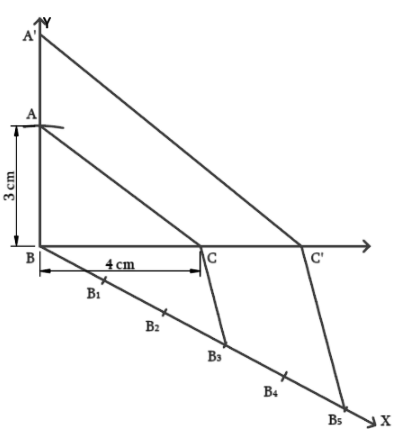
Step I – Draw BC = 4. At B, make an angle ∠CBY = 90° and mark A on BY such that BA = 3 cm. Join A to C. Thus ΔABC is constructed.
Step II – Draw the ray BX so that ∠CBX is acute.
Step III – Mark 5 (since, 5 > 3 in 5/3) points B₁, B₂, B₃, B₄, B₅ on BX so that BB₁ = B₁B₂ = B₂B₃ = B₃B₄ = B₄B₅
Step IV – Join B₃ (3rd point on BX as 3 < 5) to C and draw B₅C’ parallel to B₃C so that C’ lies on the extension of BC.
Step V – Draw C’A’ parallel to CA to intersect of the extension of BA at A’. Now ΔBA’C’ is the required triangle similar to ΔBAC where BA’/BA = BC’/BC = C’A’/CA = 5/3
Proof:
In ΔBB₅C’, B₃C || B₃C’
Hence by Basic proportionality theorem,
B₃B₅/BB₃ = CC’/BC = 2/3
CC’/BC + 1 = 2/3 + 1 (Adding 1)
(CC’ + BC)/BC = 5/3
BC’/BC = 5/3
Consider ΔBAC and ΔBA’C’
∠ABC = ∠A’BC’ = 90°
∠BCA = ∠BC’A’ (Corresponding angles as CA || C’A’)
∠BAC = ∠BA’C’
By AAA axiom, ΔBAC ~ ΔBA’C’
Therefore, corresponding sides are proportional,
Hence,
BA’/BA = BC’/BC = C’A’/CA = 5/3
Go Back To Chapters

Leave a Reply